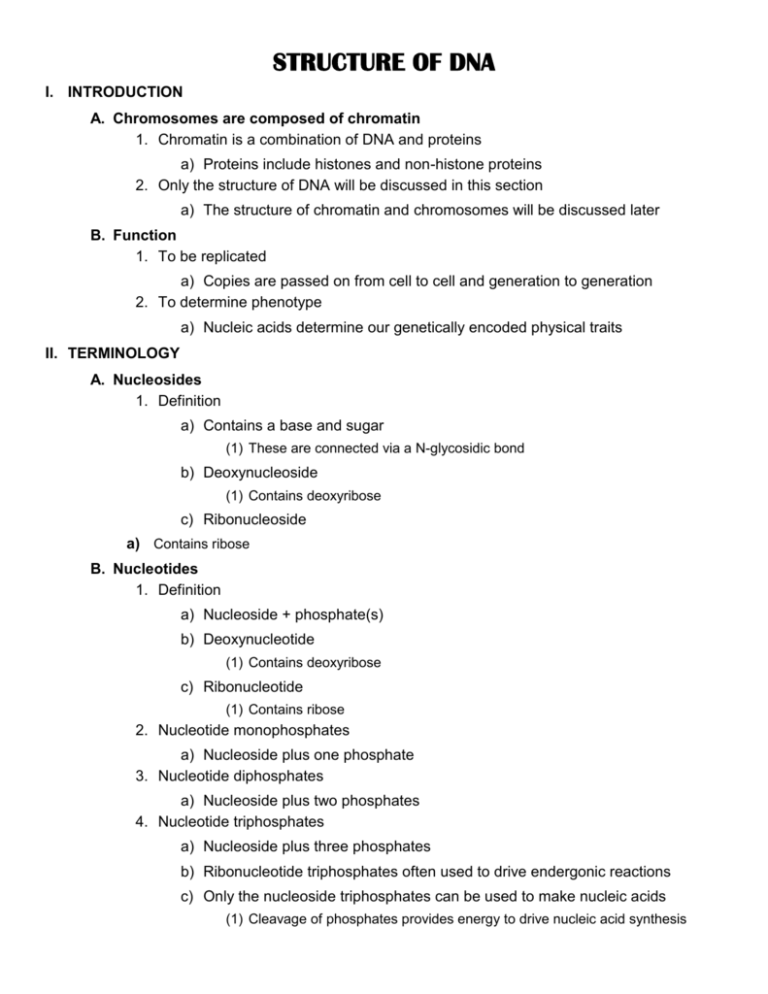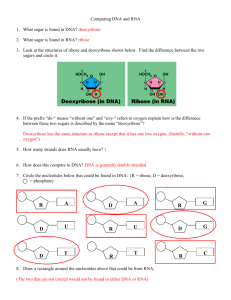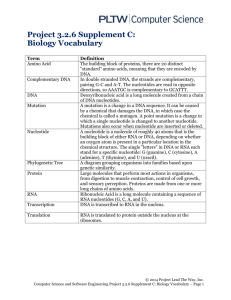11dna
advertisement

STRUCTURE OF DNA I. INTRODUCTION A. Chromosomes are composed of chromatin 1. Chromatin is a combination of DNA and proteins a) Proteins include histones and non-histone proteins 2. Only the structure of DNA will be discussed in this section a) The structure of chromatin and chromosomes will be discussed later B. Function 1. To be replicated a) Copies are passed on from cell to cell and generation to generation 2. To determine phenotype a) Nucleic acids determine our genetically encoded physical traits II. TERMINOLOGY A. Nucleosides 1. Definition a) Contains a base and sugar (1) These are connected via a N-glycosidic bond b) Deoxynucleoside (1) Contains deoxyribose c) Ribonucleoside a) Contains ribose B. Nucleotides 1. Definition a) Nucleoside + phosphate(s) b) Deoxynucleotide (1) Contains deoxyribose c) Ribonucleotide (1) Contains ribose 2. Nucleotide monophosphates a) Nucleoside plus one phosphate 3. Nucleotide diphosphates a) Nucleoside plus two phosphates 4. Nucleotide triphosphates a) Nucleoside plus three phosphates b) Ribonucleotide triphosphates often used to drive endergonic reactions c) Only the nucleoside triphosphates can be used to make nucleic acids (1) Cleavage of phosphates provides energy to drive nucleic acid synthesis III. NUCLEOTIDES A. Pentose sugars 1. Types a) Ribose and Deoxyribose (1) Deoxyribose replaces the 2'-hydroxyl group found in RNA with a hydrogen 2. Numbering of carbons a) Both ribose and deoxyribose are pentose sugars b) Carbons are numbered 1' - 5' (1) These are primed numbers so as not to confuse them with the ordinary numbers used to label the nitrogenous bases (2) 1' carbon is bound to the base via an n-glycosidic bond (3) 3' carbon is bound to phosphate of adjacent nucleotide (4) 5' carbon is bound to phosphate in its nucleotide B. Bases 1. Guanine, Adenine, Thymine, Uracil, and Cytosine a) Uracil found in RNA only; thymine is found in DNA only b) Adenine and guanine are purines (1) Having two ring structures 2. Base pairings a) Purines always pairs with pyrimidines (equal amounts) (1) Thymine - Adenine (a) 2 hydrogen bonds (b) A - U bonds may form in RNA (2) Cytosine - Guanine (a) 3 hydrogen bonds b) Denaturation studies estimate the G + C content 3. Bases have hydrophobic ring structures a) This causes them to stack up on one another, instead of facing out into the aqueous medium C. Phosphate 1. Nucleotide triphosphates are the building blocks for nucleic acids a) Two phosphates are cleaved during synthesis, the released energy used to form the phosphodiester bonds between bases 2. Phosphate is negatively charged giving DNA an overall negative charge IV. NUCLEOTIDE - NUCLEOTIDE BONDS A. Phosphodiester bond 1. A sugar attached to two phosphate groups 2. Formation of the phosphodiester bond is a dehydration synthesis reaction a) Breakage of the bond is referred to as hydrolysis b) New nucleotide always added to 3’ carbon V. CHROMOSOMAL STRUCTURE A. Overall structure 1. 2’-deoxyribonucleotides linked by phosphodiester bonds between the adjacent 3’ & 5’ sugar residues B. Size of human genome 1. 2.8 X 109 base pairs split up between 23 chromosomes a) Human chromosomes may contain 100s of millions of base pairs b) Each base pair is about 660 Daltons C. DNA is a double helix 1. Contains two strands of DNA twisted around each other a) Natural DNA is found mostly as a right-handed helix (1) It twists clockwise as it moves away from the observer 2. There is one right-turn of the helix for every 10.6 base pairs 3. The twisting of the double helix causes the formation of two grooves a) The minor groove is between the backbone of the double helix b) The major groove is between twists in the double helix D. Antiparallel 1. One strand of DNA runs 5' - 3' while the other strand goes in the opposite direction (3' - 5') VI. DIFFERENCES BETWEEN RNA AND DNA A. RNA is generally single-stranded 1. Some double-stranded RNA viruses 2. RNA may have some areas that are folded back on itself forming a local area of double-strandedness 3. If double stranded, the strands must be antiparallel B. RNA contains ribose; DNA contains deoxyribose C. Solubility 1. RNA is more stable due to the 3'-OH group of ribose D. Stability 1. RNA is less stable than DNA due to the 3'-OH group of ribose E. Bases 1. DNA contains thymine but not uracil 2. RNA contains uracil but not thymine VII. PROPERTIES A. Absorbs ultraviolet light at the wavelength of 260 nm B. Denaturation 1. Definition a) Breaking of hydrogen bonds, separating double stranded DNA into two single stranded molecules 2. Conditions a) Salt is needed to keep DNA in a double helix, as positively charged cations will neutralize the negatively charged phosphate groups on the DNA molecule (1) DNA will denature in distilled water b) Hydrophobic solvents will disrupt interactions between the hydrophobic bases, thus leading towards denaturation c) Increased temperature will break hydrogen bonds, leading towards denaturation 3. Alkali a) Base tends to change the polarity of groups involved in hydrogen bonds (1) Above pH 11.3, all hydrogen bonds are disrupted and the DNA is totally denatured C. Hydrolysis 1. Acids a) Around pH 1, the n-glycosidic bonds and phosphodiester bonds are hydrolyzed (1) This results in free bases, sugar, and phosphates 2. Alkali a) RNA is hydrolyzed into ribonucleotides around pH 11 b) DNA is resistant to hydrolysis to about pH 13 3. Nucleases a) Some nucleases degrade DNA from their ends while others cut DNA internally (1) Nucleases that degrade from the end are called exonucleases (2) Those that cut internally are referred to as endonucleases D. Extremely long and thin molecule 1. Easily breaks







